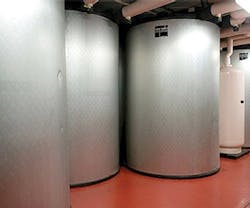Jump Ahead of the Curve with Thermal Energy Storage: Part I
What is TES?
Thermal Energy Storage (TES) is an energy management strategy that has been around a long time, is quite simple and can be very cost effective if your utility’s demand charges are high during a certain portion of the day – usually the afternoon.
Most TES systems involve making ice (or a lot of chilled water) at night and storing all of this cold mass in a tank, where it can be applied during the next day’s afternoon, when the building’s cooling requirements are greatest. By using this cold storage during the afternoon, you can reduce or completely avoid using the building’s chillers, which is how you avoid contributing to peak kW load.
This article will introduce TES (the what and the why). A follow-up article will describe the how of TES and show more calculations to determine if TES is cost-effective for your facility, and how large a system you would need. These are “rough” estimates, but can be done in minutes to determine if TES is worth pursuing. .
Why think about TES now?
I am writing about this now because I expect U.S. electric utilities to charge significantly more for demand (kW) as our grids get smarter and the intermittency of renewables becomes a larger factor in the grid cost of electricity. Renewables’ contribution to this trend is significant because solar energy is already less expensive than grid-supplied energy in certain parts of the US, and the economics of solar look better every year. The fact that consumers are using more solar is forcing utilities to re-think their business models. Some utilities are confronting an economic death spiral, because they must adapt to more consumers using solar, resulting in less revenue to the utility while still having to maintain a large infrastructure of poles and wires to support the electric grid. In several areas of the country, utilities are charging customers new fees such as infrastructure fees, whenever a solar system is grid-tied. In this configuration, the electric grid basically serves as a backup plan (battery) when the sun isn’t shining.
Because utilities will be charging more for kW partly due to the renewable energy infusion, TES is important to understand as a possible solution to the new pricing mechanisms. Just like actual batteries for solar systems, TES also plays a valuable role in helping consumers and utilities smooth out the load profile by reducing consumption spikes, creating a win-win for utilities and consumers.
TES is technically a demand-side management (DSM) strategy as it does not usually save energy, but may significantly reduce your electric bill. As a general rule of thumb, it is worthwhile to investigate DSM strategies whenever a facility has demand charges that represent more than 30% of the total electric bill. By simply re-scheduling some of your peak loads, you can significantly reduce your electric bill.
Could TES work for my facility?
When considering a TES system, a key question to resolve early is: Do you have enough surplus chiller capacity at night, so that if you ran your chillers, they could make enough ice or chilled water to have an impact on the next day’s demand? For example, in the graphic below, we can see that a 1,000 ton chiller operates at maximum capacity during the hours of noon-4 p.m. Within this period, there is no surplus chiller capacity. However, from midnight-8 a.m, the chiller is operating at a low load (250 tons) and if we were to run the chiller at full capacity, we would be creating a 750-ton surplus each hour. As the graph below shows, during midnight-8 a.m, we would create (8 hours) * (750 tons), which would equal 6000 ton-hours of surplus cold storage. We could also make another 2000 ton-hours by running the chiller at full capacity from 8 p.m-midnight. Thus we would have about 8000 ton-hours of total storage.
Economics of TES
Let's assume you are paying $15/kW per month, as measured during the peak kW window, which is usually in the afternoon (you should look up your tariff/rate schedule or call your utility to get this information). If you can implement a TES system and turn off your 1,000-ton chiller during the peak demand period, you may be able to reduce your peak demand costs by 1,000 tons. The kW savings would be calculated as follows:
First, we need to convert tons of cooling into BTUs:
= 1,000 tons * (12,000 BTU/hr)/(ton)
= 12,000,000 BTU per hour
Next, convert BTUs into kW:
= (12,000,000 BTU per hour)*(1 kW)/(3412 BTUs per hour)
= 3,517 kW of moved energy
But, to get to the input (or fuel side) of the equation, we would need to divide by the chiller’s COP (assume ~2.5). Therefore, the amount of kW avoided on the electric side of the equation would be:
= (3,517 kW of moved energy)/2.5
= 1,406 kW of avoided electric demand
Finally, convert kW savings into $ savings:
= (1,406 kW)*($15)/(kW)
= $21,102 (per month)
Of course, we are ignoring a few items such as pump energy usage, energy transfer losses, etc., but the big picture is clear: if you can save ~$20,000/month during the peak months (which might be 5 months/year), the savings is roughly $100,000/year. The savings would be more if you are on a ratcheted rate.
While the cost of the TES system involves installing a tank, pumps, heat exchangers, adjusting the chillers (if making ice), training, etc., there may be demand-side management utility rebate funding available to help offset the implementation costs. We will show the calculations for these items in Part II, which will be published next month.
---------------------------------------------------------
